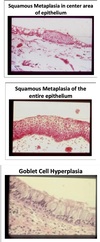COPD Flashcards
(50 cards)
COPD
Definition
Disease state characterized by airflow obstruction that is not fully reversible.
Usually progressive and associated with an abnormal inflammatory response of the lungs.
Umbrella term for many different disease processes:
- Chronic bronchitis
- Emphysema
-
Asthma
- ~ 15% of COPD patients have a reactive airways component ⇒ “asthma-COPD overlap syndrome”
- Bronchiectasis
- Cystic fibrosis
COPD
Epidemiology
- Most common pulmonary disease ⇒ 32 million in the US
- Leading cause of morbidity and mortality worldwide
-
3rd leading cause of death in the US
- ~ 20,000 deaths/yr
- Greatest cause of missed days of work
- 2nd highest cause of disability
-
3:1 male to female ratio
- Women morely likely to have COPD in countries with higher socioeconomic status
COPD
Etiology & Risk Factors
-
Tobacco smoke ⇒ leading cause of COPD
- 15-20% of long-term smokers develop COPD
- Exposure to secondhand smoke
- Inhalation of smoke ⇒ from biomass fuel or ambient particle matter
- Indoor air pollution ⇒ from heating and cooking with biomass in poorly ventilated dwellings
- Outdoor air pollution
- Alpha-1 Anti-trypsin deficiency
- Occupational dusts and chemicals
- Infections ⇒ especially severe childhood respiratory infections
- Airway hyperresponsiveness
- Gender
- Age
- Socioeconomic status
Smoking Effects
Smoke inhalation leads to:
- ⊗ Ciliary mobility
- ↑ Airway resistance by reflex bronchoconstriction
- Altered MΦ function
- Squamous metaplasia
- Mucus gland hyperplasia

COPD
Pathogenesis
Not fully understood but multifactorial.
-
Hypersecretion of mucus
- Likely a response to irritation
- Impairment of lung clearance
- Destruction of bronchial tissue
- Alterations of lung defenses
- Primary degenerative changes in collagen and elastic tissue of alveolar septa (emphysema)
-
Lung elastin damage by elastase
- Normally present in lungs but also secreted by MΦ and PMNs
- Countered by elastase inhibitors in serum (alpha-1-antitrypsin)
- Imbalance or malfunction ⇒ excess elastase ⇒ destruction of elastin ⇒ loss of elastic recoil
COPD
Pathophysiology
Airflow obstruction results from:
-
Small airways disease
- Airway inflammation
- Mucus gland hyperplasia
- Fibrosis, airway narrowing
- Loss of airway tethering
-
Lung parenchymal destruction
- Dilation/destruction of bronchioles
- Enlargement and/or destruction of acinus
- Decreased elastic recoil
Chronic Bronchitis
Definition
Clinically defined disease with increased mucous production and chronic or recurrent productive cough.
Cough:
Frequency ⇒ > 3 months per year
Duration ⇒ > 2 years

Emphysema
Definition
Morphologically defined disease with enlargement of air spaces due to destruction of alveolar septae.
⇒ Leads to loss of airway structural supoort resulting in functional obstruction to air flow
⇒ Different morphologic types

Chronic Bronchitis
vs
Emphysema

Chronic Bronchitis and Emphysema
Pathogenesis

Emphysema
Pathogenesis
Permanent and abnormal enlargement of terminal respiratory unit of acinus.
- Described as “lung dry rot”
- Alveolar distention
- Destruction of alveolar septae
- Tobacco use produces ROS that can inactivate antiproteases ⇒ “functional” α1AT deficiency

Emphysema
Types
Two main types:
- Centriacinar (aka Centrilobular - CLE)
- Panlobular (PLE)

Centriacinar
Emphysema
“Centrilobular Emphysema (CLE)”
- Selective dilatation of respiratory bronchioles and alveolar ducts
- Most common type
- Usually smoking related
- Most severe in upper lobes
- See enlarged air spaces of varying sizes

Panlobular Emphysema
(PLE)
- Dilatation of all components beyond the terminal bronchiole
- Usually occurs in the lower lung
- Severe forms in young people usually associated with α1AT deficiency
- See enlarged airspaces of uniform size

CLE vs PLE

Bullous Disease
“Paraseptal Emphysema”
- See > 1 cm dilatations of air spaces in the periphery of the lung adjacent to pleura
- Occurs adjacent to scars with aging or from unknown factors
- Does not qualify as true emphysema

Emphysema
Alveolar Changes

Emphysema
Expiration Changes

Chronic Bronchitis
Pathogenesis
May have no demonstrable pathology
or
May have any of the following:
- Smoking related changes
- Squamous metaplasia
- Loss of cilia in bronchial epithelium
-
Hyperplastic bronchial mucus glands with chronic excessive mucus secretion
- Measured using Reid index
- Inflammatory infiltrates of bronchial wall
- Globlet cell hyperplasia
- Fibrosis and atrophy of bronchial walls
- Smooth muscle hyperplasia
- Bronchial hyperresponsiveness (50% of COPD)

Chronic Bronchitis
Smoking Effects
Occurs in cigarette smokers 10-12 years after starting.
Affects 10-15% of smokers.
Reid Index
Ratio of bronchial glands to the entire thickness of bronchial wall from epithelium to top of the cartilage.
Method for measuring degree of mucus gland hyperplasia.

Chronic Bronchitis
Histology

Chronic Bronchitis
Secondary Infections
- Infections are common in the bronchi
- Leads to further destruction of bronchial tissue
-
Haemophilus influenzae colonizes airway of smokers
- Creates an immune reaction in airways
- Isolated from sputum in 60% of stable chronic bronchitis pts
COPD
Symptoms
Ranges in severity and may be applicable to all disease types.
- Cough ± sputum production
- Dyspnea ⇒ initially on exertion, later at rest
- Wheezing
- Decreased exercise tolerance
- Weight loss and lack of appetite ⇒ late
- Impaired mentation and fatigability ⇒ late and usually when cor pulmonale has occured







